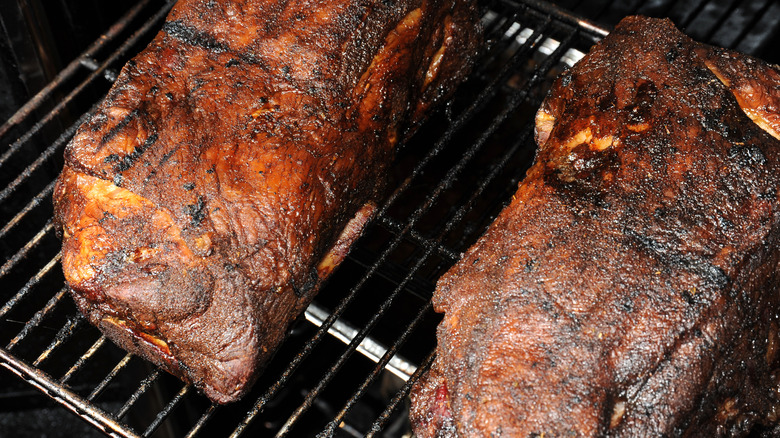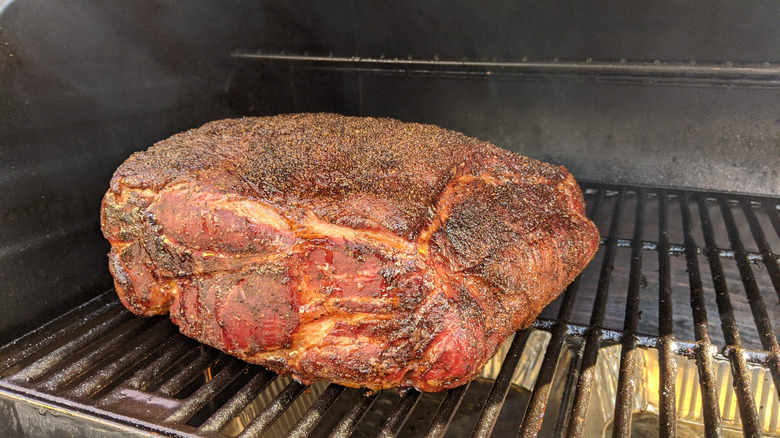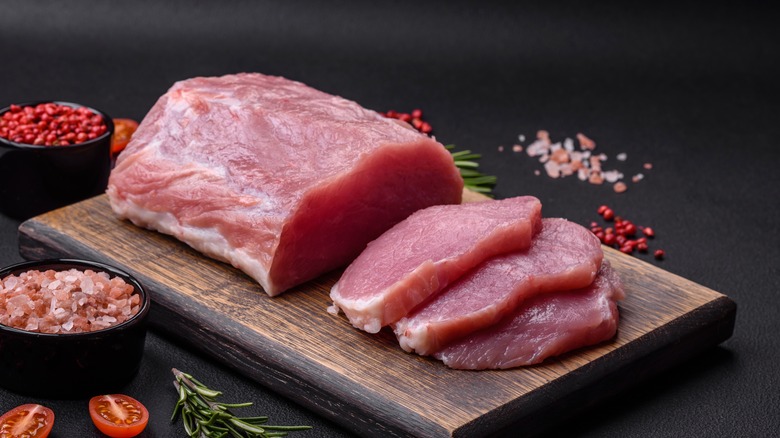The Best And Worst Cut Of Pork To Smoke
There are few cuts of pork you can't throw into a smoker for great barbecue. But to determine the best and worst cuts, Food Republic turned to the chef and owner of Clock Tower Grill, Rich Parente. "I like smoking tougher cuts, like ribs, pork shoulder, pork shank, and pork butt, which makes great pulled pork," Parente stated. However, he followed that up with: "Pork loin isn't something I'm usually going into a smoker with, as leaner cuts that cook quickly tend to have a drier end result."
Pork butt, also known as Boston butt, is the cut of choice for any pitmaster looking to dish out juicy pulled pork. Compare this to pork loin, an extremely lean and comparatively thin cut of meat that, while delicious and versatile, sits at the bottom of the barbecue totem pole. However, it is still possible to make a delicious smoked pork loin – albeit without many of the factors that people have come to love from American barbecue.
Barbecue relies on two key principles: extensive exposure to smoke, which imparts a unique flavor to the meat –and low and slow cooking times, which break down muscle fibers and melt collagen into pure flavor. This is why those tougher cuts, which are full of connective tissue, do so well when smoked.
The belle of the barbecue: bone-in pork butt
Pulled pork is the bread and butter of any pitmaster and, oftentimes, people's first attempt at barbecuing or using an electric smoker at home. Bone-in pork butt is the cut of choice for most pitmasters for homemade barbecue for several reasons.
Bone-in pork butt is cut from above the pig's foreleg, just behind its head, and most butchers cut it in a squat, rectangular shape. The bone inside pork butt is both wide and thick, running diagonally through the meat. When raw, bone-in pork butt is cheap, tough, fatty, and full of potential.
This cut has beautiful marbling and extensive connective tissue, all of which melts when cooked low and slow — and runs through the pork like capillaries of deliciousness. "There really are no bad tough cuts for a smoker since all that fat and connective tissue helps the meat stay juicy over a low-and-slow cooking process," Rich Parente explained. The uniform shape of a pork butt also helps the cut cook evenly compared to a pork shoulder, which is often cut in a triangular shape.
The size of the bone within a pork butt also works heavily in its favor inside a smoker. Bones are 40% collagen and need ample time and low heat to release that flavor potential into the meat. Additionally, that bone reduces the temperature in the meat surrounding it, helping to prevent the meat from overcooking while keeping it nice and juicy.
The lovely but lackluster smoked pork loin
It's important to reiterate that pork loin is by no means anathema to a smoker. However, there are so many cuts of pork that seem perfect for a smoker that pork loin ends up drastically overshadowed by its more delicious cousins.
Pork loin is the muscle along a pig's back and side, running from its forelegs to its back legs. It should not be confused with tenderloin, which is the muscle running directly along the sides of a pig's spine. While regarded as one of the most tender cuts of pork, its lack of fat and connective tissue make it less than ideal for smoking.
Because a pork loin doesn't have the thick bone of a pork butt or substantial fat and connective tissues, it cooks much faster. This means that the muscle fibers don't have the chance to break down nearly as much, and the meat won't have prolonged exposure to the smoke. Since barbecue's quality is often determined by these two factors, pork loin is the worst cut of pork to smoke, second only to cuts that are smoked rarely, if ever, like pig cheek or tenderloin.
If you're smoking a pork loin, watch over it carefully to make sure it doesn't dry out. With the right recipe and the time to keep an eye on it, you can still create a wonderful entree for your barbecue.



